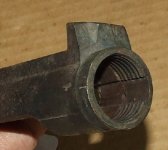I bought an Unfinished 1903 receiver. I know little about it and am looking for more info.....
Here is the sellers description:
https://jamesdjulia.com/item/lot-15...springfield-armory-unfinished-receiver-58539/
Attached are the photos. Any help would be greatly appreciated. Thank you
Here is the sellers description:
Now I have found this that has sold at auction for a fair amount, but have not found anything else (No, I am not getting my hopes up that it is worth a ton, just curious if my piece is of any significance or a paper weight). The thing I see that differs from this M1901 receiver is that it has the raised section on the bridge and it has the NS 3 marked on the bottom.Rare piece for the Springfield 1903 collector. An unfinished receiver.
Largely complete except for a few areas. Right side not milled to correct dimensions, floor is not milled out for passing cartridges thru the magazine, no serial number, Springfield or Model 1903 markings on the receiver ring. The only markings on the receiver are on the underside in the area where the bottom of the receiver would have been milled away for cartridge loading. That area is marked NS 3. Likely relating to an early batch of Nickel Steel. Nickel Steel went into use in 1928. The front ring of the barrel is threaded and cut for an extractor to move into the receiver ring when the bolt would close. The large flat area on the right side may just have been not finished, or perhaps for some design change Springfield was attempting.
https://jamesdjulia.com/item/lot-15...springfield-armory-unfinished-receiver-58539/
Attached are the photos. Any help would be greatly appreciated. Thank you





